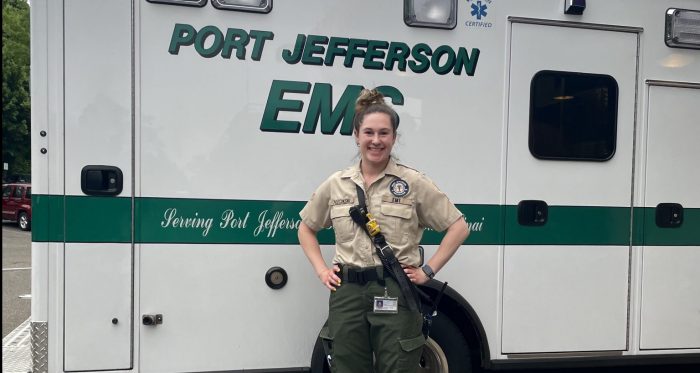Members of the nonprofit Suffolk County Landbank Corporation provided an update on the vacant Lawrence Aviation property in Port Jefferson Station during a Zoom meeting June 24. State Assemblyman Steve Englebright (D-Setauket), Town of Brookhaven Councilmember Jonathan Kornreich (D-Stony Brook) and representatives from Three Village and Port Jefferson Station/Terryville civic and chamber groups sat in on the meeting.
At the meeting, Sarah Lansdale, SCLBC president, said there are currently two proposals to install solar panels on the developed, industrial section of the property, which presently includes blighted buildings.
The 126-acre Lawrence Aviation property had been vacant for more than 20 years when it was deemed a Superfund site. The airplane parts company that once operated out of the location was accused of leaching chemicals into the ground. A cleanup was completed in 2009 and asbestos was removed from some of the buildings in 2015, according to the U.S. Environmental Protection Agency.
There are 11 claimants to the property that have been part of a settlement that has been going on for several years, according to Lansdale. The settlement agreement, signed by all claimants, is ready for final review with the U.S. Federal Department of Justice.
Among those claimants is Suffolk County, according to Peter Scully, deputy county executive and SCLBC board member. The county has not received taxes from owners since the early 1990s. Scully said that has translated into more than $18 million burden for county taxpayers. Lansdale said the EPA’s claim is more than $50 million due to its cleanup.
For the last few years, the SCLBC has been reaching out to local organizations and elected officials to discuss ideas for the future. Discussions have included using a portion of the site as a Long Island Rail Road yard to facilitate electrification of the Port Jefferson Branch. Another suggestion from community members for the site has been preserving part of it as open space.
Lansdale said the landbank has been working with Englebright and the Town of Brookhaven for requests for proposals for the industrial areas, which resulted in the two solar panel responses. She said both proposals are in conjunction with PSEG’s feed-in tariff for commercial energy production for solar. The proposals have been shared with the claimants and elected officials. Claimants have the right to veto the disposition of any offers that are received on the property per a settlement agreement.
The next step is for the landbank subsidiary “to evaluate and take action on approving one of the two proposers, the solar proposers,” Lansdale said.
“The benefits of solar is that, one, it’s consistent with the Town of Brookhaven overlay district for the Lawrence Aviation overlay, and it also does not produce as much traffic as other uses would on the site,” Lansdale said.
Scully added that since the solar panel setup is not a traffic generator, it may mean that a new access road may not be needed with the use of solar.
The offers are contingent on the buildings on the site being demolished.
“Good news is that the New York State Department of Environmental Conservation has secured a draft estimate for the cost of the building demolition, and in order to facilitate additional investigation of the site there are positive signs that the DEC is interested in moving forward on demolishing some of the buildings on-site,” Lansdale said.
The landbank has committed $210,000 from its operating reserves fund to partially fund the remaining buildings that the state DEC will not be demolishing, and $200,000 is still needed to demolish the buildings on-site.
Scully said the buildings in general need to be removed for various reasons, including unauthorized presence inside the buildings.
“We need to eliminate the attractive nuisance that these buildings have become,” he said.
Sal Pitti, president of Port Jefferson Station/Terryville Civic Association, asked if the solar panel arrays will take up the whole industrial area or would it be possible that someone else may build on that portion on the site.
Both proposals are similar, Lansdale said, in that they would take up the currently disturbed area, and it’s unlikely that it will be used for anything else. The solar panels would encompass 34 acres. Lansdale added that 40 acres of the property is currently available for open space.
As for the LIRR yard, Scully said there have been meetings with MTA representatives and LIRR leaders and there is awareness about the site and interest in it.
“There’s obviously awareness on the part of the Long Island Rail Road that this is a unique opportunity, and if it’s lost then they’ll never get another one for a site on the Port Jefferson Branch,” Scully said.

















